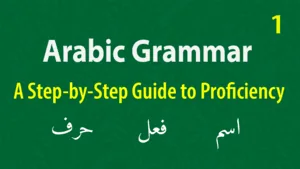Previous ➥ Lesson 10 ➥ Next
Arabic Grammar
An overview of Arabic Grammar
Related Video
Arabic is not a member of the Indo-European language group. Some grammatical terms are totally new for English speakers. Also, the grammatical terminologies that have common names in English and Arabic, might have different scopes. Like, Arabic adjectives are a subdivision of nouns. We will cover all grammatical topics step by step in the upcoming lessons. The following is the introduction of the basic structure of Arabic grammar. You should skim through the page to have a rough idea of the Arabic grammatical map.
Arabic parts of speech
The following is just an introduction to the Arabic parts of speech. They will be discussed in detail in subsequent lessons.
Parts of speech in Arabic are the same as in English. However, they are nested in form of a tree structure under a single component "kalima".
Any meaningful word is called Kalimah
( كَلِمَةٌ )
A meaningful word ( كَلِمَةٌ ) can be one of three subtypes.
اِسْمٌ Noun
Arabic noun
( اِسْمٌ )
- Name of any living or nonliving entity
- Adjective
- Verbal noun (Name of an activity)
- Adverb
- Interjection
- All types of pronouns
All the above parts of speech are just rearrangements of their English counterparts.
A verbal noun is the infinite form of a verb, to do, to eat, etc.
One new concept for English speakers is that Arabic nouns can be singular, dual, and plural. In Arabic, the plurality of a noun starts from three or more numbers of an entity. So, all nouns and verbs decline and inflect accordingly, i.e. we have a sentence structure in between "he/she does" and "they do", that is "they two do".
فِعْلٌ Verb
Arabic verb
( فِعْلٌ )
He is doing. He did.
A word that indicates activity without mentioning time is the verbal noun.
حَرْفٌ Harf
The literal meaning of Harf
( حَرْفٌ )
Like, the word on itself gives no understandable sense, but "Put it on the table" (using it with a verb and a noun) is an understandable sentence.
Arabic phrases and sentences
Parts of speech combine to make phrases and then sentences. The easier way is to start from phrases and then learn sentences.
The plural of كَلِمَةٌ (meaningful word) is كَلاَمٌ
كَلاَمٌ includes phrases (compounds) and sentences.
Arabic phrases
The most common Arabic phrases are:
The adjective phrase
اَلْمُرَكْبُ التَّوْصِيْفِيُّ
In the Arabic adjective phrase, one word describes (quality, characteristic, color, etc of) the other word.
-
A good book
كِتَابٌ جَيِّدٌ -
A red car
سَيَّارَةٌ حَمْرَاءُ -
A quick fox
ثَعْلَبٌ سَرِيْعٌ
The Possessive Phrase
اَلْمُرَكْبُ الْإِضَافِيُّ
A word in the possessive construction shows possession of the other word.
-
A book of Haamid
كِتَابُ حَامِدٍ -
A fox of a jungle
ثَعْلَبُ غَابَةٍ
غَابَةٌ means a jungle. اَلْ is the Arabic definite article. Placing اَلْ at the beginning makes it اَلْغَابَةُ (the jungle). -
A fox of the jungle
ثَعْلَبُ اَلْغَابَةِ
Same definite article اَلْ we see in names of phrases:
اَلْمُرَكْبُ التَّوْصِيْفِيُّ
اَلْمُرَكْبُ اﻟإِضَافِيُّ
Also, double vowel ( تَنْوِيْن ) is not allowed with the word having a definite article ( اَلْ ), that's why ta marbootah ة has single short vowel at the end of اَلْغَابَةُ.
The Demonstrative Phrase
اَلْمُرَكْبُ الْإِشَارِيُّ
Also, known as pointing construction. The demonstrative phrase is used to demonstrate far and near nouns and pronouns. English equivalents are this, that, they, etc
-
This book
هٰذَا الْكِتَابُ -
That car
تِلْكَ السَّيَّارَةُ
The Prepositional Phrase
اَلْمُرَكْبُ الْجَارِيُّ
The prepositional construction or prepositional phrase is:
-
On the book
عَلَى الْكِتَابِ -
In the car
فِي السَّيَّارَةِ
Arabic sentence
جُمْلَة
Arabic sentences are of two types.
- Nominal sentences are verbless sentences.
- Verbal sentences have verbs.
Nominal sentence
الْجُمْلَةُ الِْاسْمِيَّةُ
The name اِسْمِيَّةٌ
The book is new.
اَلْكِتَابُ جَدِيْدٌ.
The elephant is big.
اَلْفِيْلُ كَبِيْرٌ.
Verbal sentence
الْجُمْلَةُ الْفِعْلِيَّةُ
The name فِعْلِيَّةٌ
The child is playing in the garden.
يَلْعَبُ الطِّفْلُ فِي الْحَدِيْقَةِ.
The teacher came.
جَاءَ الْمُعَلِّمُ.
Previous ➥ Lesson 10 ➥ Next
